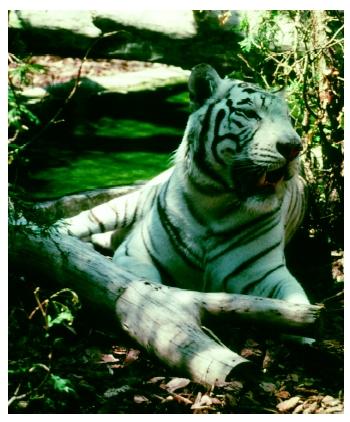Endangered Species
Endangered species are species of plants or animals (or other life forms such as fungi) that are threatened with extinction. As well as being a biological term, "endangered" has a formal political meaning: nations, states, and other organizations evaluate the status of species and determine which are in the greatest danger of going extinct; these species are designated as endangered species. Other species that are declining rapidly in numbers, but are not yet believed to be on the brink of extinction, are designated as threatened species. In the United States, the Endangered Species Act protects such species.
Several factors can cause a species to become endangered. The most common cause is loss of habitat. Much of the world's forests, grasslands, and wetlands are being transformed into agricultural and urban areas, and many species that lived in those habitats are unable to adapt to the new environment. As a result, their numbers can drop greatly in a very short time. In some cases, human hunting or gathering of particular species can drive a species to the brink of extinction. This is the case of the rhinoceros, which has been killed in large numbers during the past century to meet market needs in certain areas of the world. The horn of the rhino is prized for dagger handles in the Middle East and for medicinal uses in parts of Asia. Tigers

Protection and Reestablishment
There are several ways that people can try to protect endangered species and to keep them from going extinct. One important way is to set up special protected areas around some of the last remaining populations of a species. China has created such reserves for the giant panda. However, for these reserves to be successful, they need to have the support of the resident people that live around the reserve. In some cases, the reserves provide the local people with jobs, and in other cases, some agricultural and even hunting activities are permitted within the reserve.
For some species, their habitat has essentially disappeared, or the species has declined to only a few individuals. In these instances, the only feasible way to try to preserve the species is to bring all the remaining individuals into captivity. One important function of zoos today is to house such endangered species. In some cases, captive breeding programs are initiated to increase the number of individuals of the endangered species. The ultimate goal of many of these captive breeding programs is to reintroduce the species back into the wild at some future date.
There are several ongoing reintroductions. In the 1980s, when the California condor had declined almost to the point of extinction, the few remaining individuals were captured and placed in captivity. A successful captive breeding program increased the numbers to several dozen individuals, and some have been released back into the wild. Reintroductions of endangered species are not always successful because the reintroduced animals usually have lived only in captivity. Thus, it is often necessary to prepare these animals for their new life in the wild by teaching them how to catch their food and to avoid predators.
Probably the greatest success story of the recovery of an endangered species involves the national bird of the United States, the bald eagle. The bald eagle, like many other birds of prey, fell victim to the heavy use of pesticides by farmers in the 1950s, including DDT. Much of the DDT that was sprayed onto agricultural fields ran off into streams and rivers and lakes when it rained. Small aquatic life consumed some of this DDT, and it remained in their body tissue. When a small fish ate these small aquatic organisms, DDT accumulated in their bodies too and was passed on when a larger fish ate the smaller fish. This process has been referred to as bioaccumulation, or biomagnification.
Thus, by the time the bald eagle ate the larger fish, it was eating contaminated food, and the eagles' own tissues accumulated high concentrations of DDT. One unfortunate consequence of these high concentrations of DDT was the severe weakening of the eggshell laid by the eagle. They were so weak they would often break during the normal parental brooding of the eggs. As a result, the birth rates of the eagles plummeted at the same time the death rates from DDT poisoning rose.
In response to environmentalists like Rachel Carson, who saw how the use of these sorts of chemicals was harming wildlife, the United States banned further use of DDT and provided the bald eagle with special protection under its endangered species status. The eagle populations responded slowly, but in the 1990s the populations began to increase at a rapid rate. In the early twenty-first century, the bald eagle is seen commonly in many parts of the United States and Canada, and its numbers have increased substantially enough that it is no longer considered an endangered species.
SEE ALSO Biodiversity ; Carson, Rachel ; Extinction ; Pollution and Bioremediation
Mark A. Davis
Bibliography
Primack, Richard B. Essentials of Conservation Biology. Sunderland, MA: Sinauer Associates, 1998.